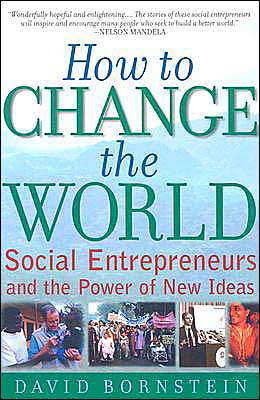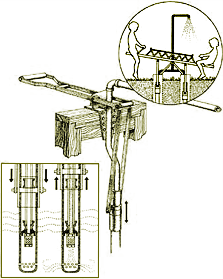| With the drama and urgency of a sportscaster, Hans Rosling debunks a few myths about the "developing" world. Rosling is professor of international health at Sweden's world-renowned Karolinska Institute, and founder of Gapminder, a non-profit that brings vital global data to life. (Recorded February 2006 in Monterey, CA. Duration: 20:35) - More TEDTalks at http://www.ted.com Go play with the tool, it's free! http://www.gapminder.org | |
Sunday, December 24, 2006
Fun with Statistics: Myths about the developing world, by Hans Rosling
Thursday, December 14, 2006
Press (1) if you are a For Profit Social Venture
The New Ventures program of the World Resources Institute supports sustainable small and medium-sized enterprise (SME) creation in emerging economies. The program accelerates the transfer of venture capital and management expertise to outstanding investment opportunities in fast-growth, environmental sectors such as ecotourism, non-timber forest products and certified wood, organic foods and fibers, renewable energy, sustainable fisheries management, and clean technologies. This page contains research and interviews produced exclusively by the New Ventures team.
Competition: 2007 National Idea-to-Product (I2P) Competition

The 2007 National Idea-to-Product (I2P) Competition for EPICS and Social Entrepreneurship is currently seeking three social entrepreneurship projects to be showcased at their March 24, 2007 Competition. This is the second year for the I2P "on the road" competition which will be hosted by Princeton University.
An Idea-to-Product competition is a product feasibility competition, not a business plan competition. The showcase teams will be allotted ten minutes for presentation and 15 minutes for questions and answers. The team must have a product, prototype or well defined concept to be eligible. In the event a product is too large to transport to Princeton N.J., a poster and/or video presentation may be substituted for a live product demo.
To help support further success of the project, each showcase team will receive a participation award of $1,000.
Provide information on your program, mission and product by December 31, 2006. The I2P Team will review the information and choose 3 projects.
http://innovate.ecn.purdue.edu/
Tuesday, December 12, 2006
The Acumen Fund on BusinessWeek
Acumen is a leader in the fast-emerging hybrid sector that straddles private industry and nonprofits. Technically a nonprofit, it invests in enterprises in developing countries with the strategy and discipline of a Silicon Valley venture-capital firm.
Acumen's founder is Jacqueline Novogratz, a former banker with an infectious magnetism and a melodic voice that delivers a constant call to action. Under her leadership, the fund manages $20 million in investments that fall within three portfolios: health, water, and housing. But Acumen's goal is far larger than successful companies. Says Novogratz: "We're creating an overall design for how you provide goods and services to poor people."
Saturday, December 9, 2006
You don't always need a wheelchair
http://www.thinkcycle.org/photo-album/album?album_id=54695
 |
Practical Action

Found this on Thinkcycle (who knew people were still using Thinkcycle!?)
The website reads,
Practical Action was founded in 1966, as ITDG (the Intermediate Technology Development Group), by the radical economist Dr EF Schumacher to prove that his philosophy of 'Small is Beautiful' could bring real and sustainable improvements to people's lives.
They have lots of projects and technologies deployed. No medical devices that I can see, nevertheless, some interesting ones:
The most popular downloads last month:
1. Recycling of plastics
2. Dyeing textiles
3. Papermaking
4. Wind for electricity generation
5. Oil extraction
6. Solar distillation
7. Cashew nut processing
8. Packaging materials
9. Yoghurt
10. Hydraulic ram pumps

Two linked trolleys, on pulleys, run on separate 10mm diameter steel wires which are suspended from towers: as the full trolley comes down, pulled by the weight of its load, it pulls the empty one up, ready for the next load. The trolleys' progress is controlled by another, 8mm wire, looped over a flywheel. A wooden drum brake, with bearing and bracket, governs their speed.
Non electric refrigeration

BoingBoing reports that
"Mohammed Bah Abba of Nigeria won a Rolex award for his "pot-in-pot refrigerator. It consists of a smaller clay pot inside a larger clay pot. The gap is filled with damp sand. As the sand water evaporates, the inner pot cools. Food that used to spoil in a few days now stays fresh for weeks. Second-order effects are already being noticed -- for one thing, girls who had to skip school to sell food at markets can now attend classes."
More at WorldChangers
Update: These guys are 4 years late in reporting. Our trusty folks at Scientific American covered this in 2000. Their Science and the Citizen section is great.
Open Prosthetic Project
The trend to a physical device model in open source design (see BusinessWeek article) has been tepid. Projects like Thinkcycle are one way to go. Recently, I ran into the The Open Prosthetic Project. It is one of the most interesting ideas I have run into in a long time. Wired magazine wrote about them a while back
Founded last year, the nonprofit Open Prosthetics Project applies the ethical and intellectual property foundation of open-source software to the task of building better artificial limbs. The project releases its experimental designs to its website in the public domain, free for anyone to use, forever. Anyone can download the STL files, tinker with them in CAD software, and submit them to a rapid manufacturer, such as a prototyping 3-D printing company.
and in the same project, an inspiring story of a father who made a prosthetic fishing rod for his son:
Man makes prosthetic fishing rod for son
 Robert Haag has put together an amazing Spiderman fishing pole / prosthetic arm for his young son. It's part of the "Open Prosthetics Project," which aims to share ideas and inventions for prosthetic devices. Link | Video of kid practicing with the rod
Robert Haag has put together an amazing Spiderman fishing pole / prosthetic arm for his young son. It's part of the "Open Prosthetics Project," which aims to share ideas and inventions for prosthetic devices. Link | Video of kid practicing with the rodSome thought provokers:
Applications include, of course, war veterans and civilian victims. For developing countries, given the high amount of manual labor involved in many jobs, what types of tools can be attached to a prosthetic that gives that person newfound ways to earn a living?
Spray paint cans
Machetes? Shears?
Watering and planting tools?
Books: Rx for Survival and How to Change the World

 A must read.
A must read.Rx for Survival
 the story of Grameen Bank, has an excellent volume in How to Change the World
the story of Grameen Bank, has an excellent volume in How to Change the WorldBetter Bananas, Nicer Mosquitoes
In the hallways and over cocktails and dinners -- all paid for by the foundation -- virologists and neurologists talked with plant biologists and nanoparticle physicists, sometimes finding ways to help one another. For example, a scientist with plans to improve vitamin-fortified ''golden rice'' asked the designer of a hand-held laboratory to test blood for pathogens whether it could be modified to test blood for iron and vitamins.
Also lab on a chip type of stuff
[Dr. Paul Yager's] prototype, will test a finger-stick drop of blood for flu, malaria, typhoid, dengue, measles, rickettsia, salmonella and other fever-causing infections -- a tall order, because the infecting agents range from minuscule viruses to relatively immense parasites.
Ideally, the blood will be dripped into a well in a 30-layered piece of disposable plastic the size of a thick credit card, divided and sucked down 16 hair-narrow channels, mixing with reagents stored dry in tiny pits on the cards.
Clinical Trials--In India
The need to cut costs is persuading US and Western European firms to seek alternative destinations such as China and India for clinical trials. Another factor in this decision is that India and China have joined the World Trade Organization (WTO), which has invigorated both countries� economies. As a result, clinical trials conducted in these countries are no longer confined to evaluating new medicines for their own markets. India and China have opened up new opportunities for US and Western European firms to expand their pharmaceutical and biotechnology product markets substantially. In 2006, the global clinical trials sector is estimated to be about $10 billion and has the potential for considerable growth over the next few years.Wired Magazine has a more somber outlook, their article, A Nation of Guinea Pigs is worth looking into
Kalantri is uneasy about his clinical success. "Patients here are very passive," he reflects. "They will almost never question their doctor." Indeed, one woman who joined the trial six months ago sits patiently for more than an hour while Kalantri translates my questions, before revealing that she is suffering from aches and fever that are likely malaria. Such deference is hard to imagine in US patients - a querulous lot - and it makes Kalantri's position tricky. "Nine out of 10 times," he says, "the patient will just ask me to make the decision about the trial for him. So what role do I play? Am I a physician, concentrating on what's best for the patient? Or am I a researcher interested in recruiting patients? I try to balance the two sides, but ..." He shrugs. "It's a dichotomy." Kalantri began worrying
And more recently they reported that
Companies are attracted to India not only because of the huge patient pool and skilled workers, but also because many potential study volunteers are "treatment naïve," meaning they have not been exposed to the wide array of biomedical drugs that most Western patients have, said Stefan Ecks, a lecturer in social anthropology at the School of Social and Political Studies in Edinburgh who recently published a paper on the marketing of antidepressants in India.Our humble experience note: We actually spoke with some industry figures in Boston while they were on a trade mission from the state of Gujarat. According to them, the press is naturally going to blow a lof of the outlier claims out of proportion. Perhaps this is an opportunity for India to participate in cutting edge research and have a population that can benefit from promising drugs. Hey, while we they are at it---we don't mind the oversight!
And for the conspiracy theorists

Harvard Biotech Offers Cliff Notes for Startups
Graphic Facilitation


Wired: Graphic Facilitation
Tired: PowerPoint Presentation
Expired: Overhead slides
I saw one of the these at a consulting company a year ago, and I thought they looked so neat. An excellent way to show complex concept that pop up and move away from PowerPoint syndrome. Click on the picture for a bigger version.
Click on the picture for a bigger version.
www.xplane.com
The Grove
Friday, December 8, 2006
Freeplay Energy---power up those medical devices

Check out FreePlay Energy
The Economist has an article.
With its new range of portable and robust wind-up medical devices, Freeplay aims to revolutionise health care in the developing world.
Cheap is Beautiful

Design that Matters has a wonderful project called the Kinkajou---a low cost microfilm projector intended to help people go to school at night (since many parts of the world require that the work during the day). Their value proposition is amazing. They took a creative approach to building the device, and of course, a major requirement was price. The result is a a projector that currently costs around $200 but if enough units are produced, they aim to lower that to around $50.
Our own little device that could, the SafePilot, was able to replicate the same model. The assistive device for the blind creates similiar features that a laser cane (retail price $250) provides, but for a lot less $$$. Price is not yet set, but we're hoping for a sub-$100 model in 2007. Stay tuned.
What's Wrong With Profit?
 Also featured is something called PlayPumps---I'm absolutely fascinated by the idea.
Also featured is something called PlayPumps---I'm absolutely fascinated by the idea.Read the rest of the article
It's also something I saw in the book Gaviotas.

See-saw pump“In the open-air Gaviotas preschool, the children’s see-saw is actually a pump in disguise. As they rise and descend, water gushes from a vertical pipe into an open cement tank. Over the years Gaviotas technicians have installed these in thousands of school yards, using kid power to provide villages with clean water. This simple, inexpensive pump has revolutionised rural life across Colombia for people who used to haul their water in buckets from muddy tropical rivers.”
Hedge Funds With A Heart
Read More


